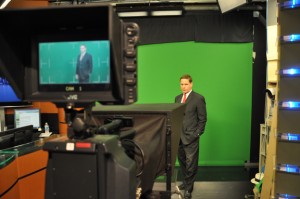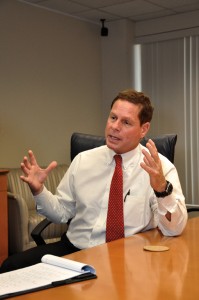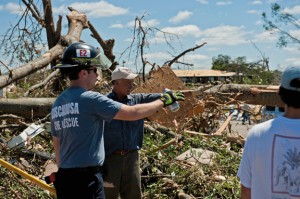In The Eye of the Storm
Posted on July 27, 2011 by bob in Features
 by Lenore Reese Vickrey; photos by Bob Corley
by Lenore Reese Vickrey; photos by Bob Corley
Rich Thomas has been living and breathing the weather since the third grade when his teacher in Sheffield Lake, Ohio, assigned the class a project: Go home and make a weather instrument.
He made a barometer. The project earned him a “C.”
Undeterred, nine-year-old Thomas was bitten by the weather bug and the science of forecasting. He staged make-believe forecasts for his parents, became the National Weather Service’s youngest cooperative observer for Ohio at 13, and did weather casts for fellow high school students.
August 3rd marks his 30th year at WSFA, where he has been bringing central and south Alabama viewers their highs and lows and weather warnings since 1981.
“It’s an awesome responsibility,” says Thomas, whose boyish looks belie his 55 years. “I understand that I’m an ambassador for the station, and it’s part of my job. People rely on you.”
Thomas began his broadcast career in his 20s after graduating from the University of Southern Mississippi in broadcast communications, and later studying meteorology at Mississippi State. In 1977 he was working as a disc jockey at WHSY-AM in Hattiesburg, a sister station of WHHY in Montgomery, when WHHY’s Larry Stevens hired him away.
Thomas worked as a deejay and in news and weather from 1977 to 1981.
“I was the go-to guy because there was only me (on the air) when there was bad weather,” he said.
His reporting skills caught the ear of Carl Stephens, then program manager of WSFA, who asked if he’d considered working on TV.
“And that was the only thing I wanted to do!” Thomas auditioned, but he didn’t think it went well. But he’d no sooner returned home when the phone rang, and he was told he had the job of weekend meteorologist.
“Back then, [forecasting] the weather was not sophisticated, “ he said. “All we had was the Teletype machine and color radar. The skywatch/warning map was very simple. There was just an outline of the state, with dots for the cities. If there were severe weather, the dot would be blinking. If the dot was steady, it was under a watch. If it wasn’t on, you were OK.
“We’d talk about the nation, then go to the chroma key (also known as blue or green screen technology which makes it appear as if the weather forecaster is standing in front of a map, but he’s actually in front of a blue or green screen).
“ Nowadays we don’t talk about the nation, we talk about what’s going on here. The style has changed, and so has the technology.”
He uses software to prepare his forecast and create maps.
“I build maps all day long,” Thomas says. “I know what story I want to tell, and I think about what graphics I need. Even with all the bells and whistles and technology, it’s important to focus my storytelling on the main elements.”
In the early 80s WSFA had only three newscasts: noon, 6 and 10 p.m. It wasn’t until the mid- to late 80s that the first PC was used in weather forecasting at the station. But it changed everything.
“We started getting images through the computer,” says Thomas, “and by the early to mid-90s the weather map had become much more sophisticated.”
When Dan Atkinson left in 1983 for WSB-TV in Atlanta, Thomas was promoted to chief meteorologist. He also did commercials and co-hosted both “Young World,” and the syndicated “PM Magazine.”
His first big weather event was May 3, 1984, when a tornado struck about 7 a.m., killing five people on the Northern Bypass. More tornadoes struck that afternoon, with a funnel cloud even passing over the station. The power went out but the broadcast continued with an emergency generator, one camera and a light.
“We went wall to wall (continuous coverage),” he said. “I was 28 years old, and it was a trial by fire!” The station general manager was so impressed with his coverage that day he gave him $100.
There were many other days of severe weather, and Thomas can rattle them off: Oct. 4, 1995 – Hurricane Opal; Sept. 16, 2004 – Hurricane Ivan; Aug. 28, 2005 – Hurricane Katrina (and tornadoes in Alabama); March 1, 2007 – Tornado in Enterprise; Feb. 7, 2008 – Tornado in Prattville.
Nothing, however, would rival the outbreak of tornadoes in April of this year. The first was Apr. 15, when 53 twisters struck in one day. On Apr. 27 the worst tornado outbreak in the U.S. since 1974 occurred, when an estimated 346 persons were killed.
“I remember saying on April 15, ‘Well, we’ll never see an outbreak like that again. But 12 days later there are no superlatives to describe what happened on April 27.”
In Alabama alone there were 108 tornadoes, more than typically struck in an entire year.
Thomas and his fellow meteorologists broadcast non-stop. They had been predicting potentially dangerous storms for five days before, but nothing could have prepared them for what was to come.
“I’m doing the 5 p.m. newscast and my producer tells me we have a live shot from WBRC, live from Tuscaloosa,” he recalls. “Here is this massive tornado coming and people are losing their lives….”
His eyes fill with tears as he recalls what was going through his head, but he managed to maintain his composure on-air and keep talking.
“I’m looking at this, people are screaming in my earpiece, and I know people out there are relying on my information, but I’m thinking, ‘Oh, my God. There are a lot of people dying right now.’”
“I can’t remember a weather event like that in 30 years,” he said. “You just go on automatic and you’re on adrenaline. You have to sound authoritative and not emotional. But later it hits you.”
The heavy responsibility he feels towards his viewers hit home two days later. A man who heard him on the radio (Mix 103, which simulcasts WSFA during severe weather), told him,
“Because of you guys, I’m alive today.”
Producing the weather not only for TV but also for radio is another example of how technology has improved access to weather information. Thomas is also responsible for weather reports on the digital channels, WSFA.com, Facebook and Twitter.
“There’s no spare time,” he admits, sipping a V-8 juice between taping promos and a forecast that will be shown on the Jumbotron at the Biscuits game.
“Most important is our weather app for your phone,” he said. “We are wherever you are. I can’t imagine where we’ll be in five years. I’ll be coming out of your toaster when you’re making toast!”
Spare time is indeed a precious commodity, and when he’s away from the station Thomas likes to travel, tinker with technology, relax with friends, grill out and walk his dog, Skyy.
Although the requests are overwhelming, he enjoys responding to children’s questions and speaking to school and civic groups.
“I happen to work at a ‘storybook’ station,” he says. “I always wanted to work in TV like this. Now how great a story is that?”















2 Responses to “In The Eye of the Storm”